Upper Limb Pain

Common Upper Limb Pain in Children and Young People
Upper limb musculoskeletal pain in children and adolescents can result from a variety of causes, including sports injuries, overuse, or developmental issues.
Common Conditions
Little League Shoulder
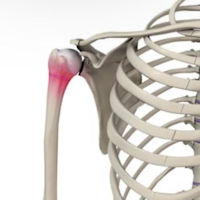
This condition is common in young athletes who participate in throwing sports, such as baseball or volleyball. It involves inflammation and stress injury to the growth plate in the shoulder (proximal humerus). Pain is sometimes felt during activity but more often is felt after finishing the activity.
- Rest from sports participation involving throwing.
- Ice shoulder daily- wrap ice pack in a towel and ice for 15mins 2-3 times a day.
- Stretch muscles around shoulder.
- Once pain has reduced gradual strengthening of the muscles around the shoulder helps to support proper function. See shoulder strengthening exercises further down on this page.
- Graded return to sport once pain has settled.
Little League Elbow- pain felt on inner side of elbow
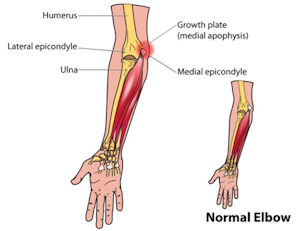
Similar to Little League Shoulder, this condition affects the elbow, specifically the growth plate on the inner side of the elbow (medial epicondyle). It is caused by repetitive throwing motions, leading to pain and inflammation. Pain is sometimes felt during activity but more often is felt after finishing the activity.
Management strategies:
- Rest from sports participation involving throwing.
- Ice elbow daily- wrap ice pack in a towel and ice for 15mins 2-3 times a day.
- Once pain has reduced gradual strengthening of the muscles around the elbow helps to support proper function. See elbow strengthening exercises further down on this page.
- Graded return to sport once pain has settled.
Repetitive Strain Injuries (RSIs)
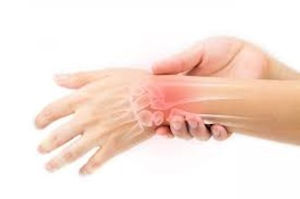
RSIs, such as tendinitis or bursitis, can most commonly in the upper limbs in the elbows or wrists due to repetitive activities like typing, texting, or certain sports. These injuries cause pain and discomfort in the muscles, tendons, or joints of the arm, wrist, or hand.
Management strategies:
- Rest from sports participation involving upper limbs
- Reduce time spent gaming or using tablets/ mobile phones.
- Ice elbow/wrist daily- wrap ice pack in a towel and ice for 15mins 2-3 times a day.
- Stretch muscles around elbow/wrist- see stretches further down on this page.
- Once pain has reduced gradual strengthening of the muscles around the elbow/wrist helps to support proper function. See strengthening exercises further down on this page.
- Graded return to sport once pain has settled
Shoulder Instability
Shoulder instability is multifactorial and an umbrella term for conditions where the joint needs more muscle strength to support it through movement. In children, this condition can be caused by various factors, including previous trauma/ dislocation, sports injuries, increased flexibility, or genetic conditions that affect joint stability. Pain may be felt during or after physical activity, the shoulder may feel weak or unstable and there may be a loss of range of motion.
Management strategies:
- Strengthening muscles that add stability to shoulder.
- Exercises that improve the range of motion of the shoulder
- Advice on activity modification
- Graded return to sport/ function
When to Seek Professional
Please speak to your GP about a referral to paediatric physiotherapy if:
- Your child experiences persistent upper limb pain, difficulty participating in activities, or if the pain affects their daily life.
- Your child experiences any swelling
- Your child has a new onset of upper pain following an injury (if they are unable to weight bear through the upper limb, there is swelling/ bruising and loss of range of motion please attend A+E for assessment for a fracture)
Upper Limb Exercises
Please also visit our Strength and Conditioning for Flexible Joints page for further advice.
Exercises to help with movement
Shoulder Pendulum exercise
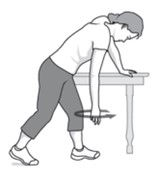
- Lean onto a table with your good arm, letting your affected arm dangle forwards in front of you.
- Using gentle movements of the body, let this arm swing backwards, forwards, side to side, and in circles.
- Complete 30sec x3
Shoulder flexion with stick
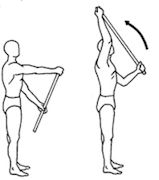
- Sit or stand upright.
- Hold a stick vertically in both hands with the hand of your affected arm on top of the stick.
- Place your other hand further down.
- Keeping your posture straight and your shoulders back and down, push your affected arm up towards the ceiling using the stick with your unaffected arm.
- Hold this position a couple seconds, ensuring you relax your affected shoulder, preventing it from hunching up.
- Control the movement as you lower it back down to the starting position.
- Aim 10 repetitions, three times a day.
Shoulder abduction with stick
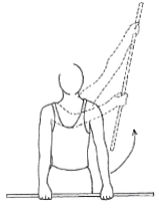
- Hold a stick in both hands and hold it in front of you.
- Push across your body with your good arm, lifting your affected arm out to the side.
- Be careful not to hunch your shoulders up or twist your body around.
- Control the movement back down carefully.
- Aim 10 repetitions, three times a day.
Elbow flexion and extension with overpressure
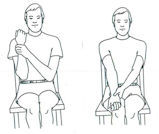
- Start in a seated position.
- Bend your affected elbow, bringing your hand up towards your shoulder.
- Use your other hand to assist this movement and increase the bend.
- Hold this position.
- Place your arm to be stretched on a towel on the table.
- With your palm facing up, straighten your elbow as far as you can.
- Using your other hand, straighten your elbow further.
- Aim 10 repetitions, 3 x daily
Upper Limb Stretches
Inner elbow forearm stretch
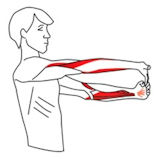
- Start in standing or seated
- Extend your affected arm straight out in front of you with your palm facing upwards and drop your hand towards the floor.
- With your other hand, apply a gentle pressure to your palm downwards and hold.
- Hold 30seconds, complete 3x daily
Outer elbow forearm stretch
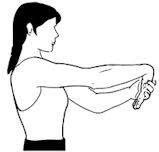
- Start in standing or seated
- Extend your affected arm straight out in front of you with your palm facing downwards and drop your hand towards the floor.
- With your other hand, apply a gentle pressure to your hand downwards and hold.
- Hold 30 seconds, complete 3x daily
Upper limb strengthening
Resisted scapula retraction
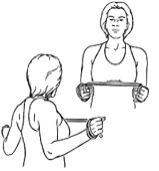
- Stand up straight holding a resistance band in both hands.
- Relax your arms by your side, your gaze directly ahead and your shoulder blades relaxed.
- With your elbows bent and your palms facing forwards, pull the band backwards, generating the movement from between your shoulder blades.
- Hold this position, then control the movement as you return to the starting position and repeat.
- Aim 10 x3, 3-4 times a week
Resisted elbow flexion
- Start in a seated position.
- Anchor the band underneath your feet in order to create tension in the band.
Resisted elbow extension
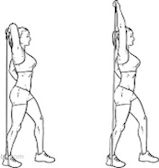
- Start in a standing position.
- Anchor the band underneath the feet and keep your feet shoulder-width apart.
- Grasp the end of the band in one hand and extend the arm straight above your head.
- Use your opposite hand to assist your elbow for support.
- Bend your elbow so your arm lowers behind you, then return to the fully straightened position.
- It is important to stabilize your elbow with the opposite hand so your elbow stays close to your ear.
- Aim 10 x3, 3-4 times a week.
Gripping exercises
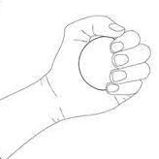
- Sit upright in front of a table.
- Place your weaker arm onto the table with your elbow bent and hold a tennis ball in your palm.
- Squeeze the tennis ball in your hand and hold this position before relaxing your grip.
- Aim to keep your elbow, shoulder, and body still during the exercise.
- Aim 10 x3, 3-4 times a week.
Resisted wrist flexion and extension
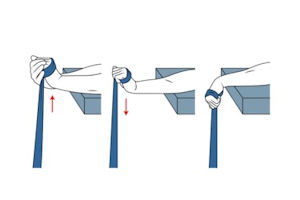
- Sit in a chair with a table to your side.
- Place your weaker arm onto the table with your elbow bent and allow your hand to rest over the edge of the table with the palm facing down.
- Take one end of the resistance band in your hand and hold the other end in your other hand.
- Take up the tension in the band, then lift your wrist up as far as you can, keeping your forearm in contact with the table.
- Hold this position before slowly lowering it back down.
- Turn your hand over with your palm facing up.
- Keeping your good arm still, lift your other wrist up as far as you can, keeping your forearm in contact with the table.
- Hold this position before slowly lowering it back down.
- Aim to keep your elbow, shoulder, and body still throughout whole exercise.
- Aim 10 x3, 3-4 times a week.
Exercises for shoulder strengthening and shoulder instability
Falling press up against wall in standing
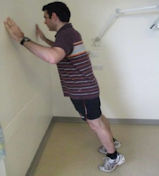
- Fall against the wall and uses 2 hands to absorb the impact. Then push away fast from the wall to the original standing position
- Aim 50 repetitions twice a day
Falling press up to waist level
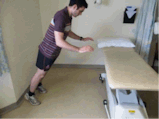
- Fall against your kitchen worktop and uses 2 hands to absorb the impact. Then push away fast from the wall to the original standing position
- Aim 50 repetitions twice a day
Push up with clap

- Start in push up position, push away with arms and clap in air, return to start position.
- Aim 20 repetitions twice a day
Doorway fall
- Stand one step away from a doorway. Fall through the doorway and catch your bodyweight with two hands on the frame of the door.
- Then explosively push back up to the original standing position
- Aim 20 repetitions twice a day
Single hand rolling ball on wall
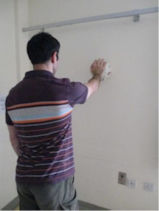
- Lean on a ball in a standing position.
- Roll the ball up and down slowly and as smoothly as possible.
- Once you can do this easily for 60 seconds they progress to making circles with the ball on the wall or writing out the alphabet and spelling your name on the wall.
- Aim 60 seconds twice a day
Superman
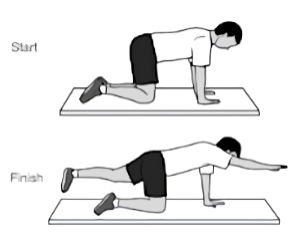
- Start on both hands and knees.
- Bring one leg up and straighten at the knee as far as possible whilst maintaining a level pelvis.
- Then bring the opposite arm up so that it is pointing straight forward.
- Maintain this position for 3x20 seconds on each side
- Complete this exercise daily.
Bear walking
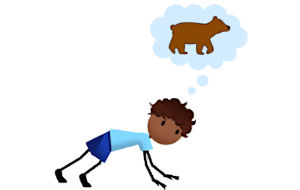
- Start with your hands and feet on the floor.
- Move your opposite arm and leg forwards so you are walking on your hands and feet like a bear.
- Your heels should stay on the floor and you should push your knees straight with each step so that you are stretching your calf muscles.
- Aim for 30seconds x 5
Wheelbarrow walking
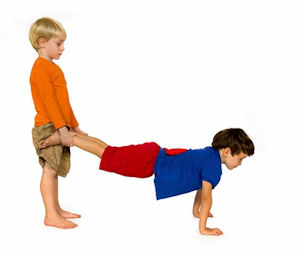
- Have child positioned on hands and knees
- Grab the childís legs and lift them so their hands are pushing down on the floor. li>Use your hands to support your childís legs while child walks on their hands.
- Be sure to cue the child to lift their head to look at the toy they are walking to. Make sure the child's back is straight and not bent in anyway.
- Aim 30seconds x 5
At what point will these exercises start to make a difference?
The above exercises can assist with managing symptoms at home. Most musculoskeletal conditions see improvement within 8-12 weeks.
Last updated10 Sep 2025

